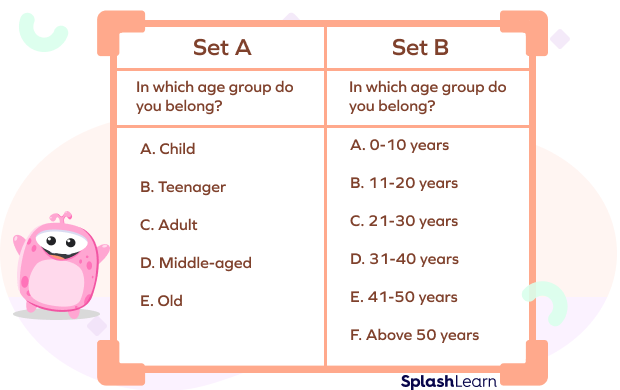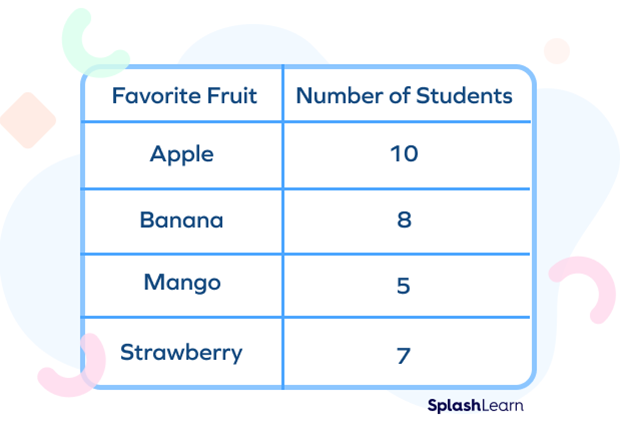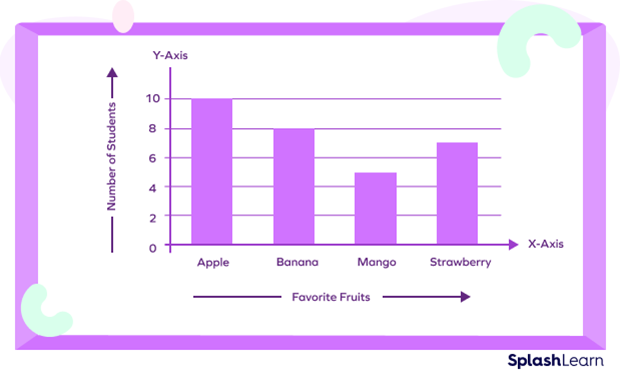
What Is a Survey in Math?
A survey in math is a method of data collection used to gather information about people and their behaviors or opinions by asking them a list of questions. It is the most common and inexpensive method of collecting data.
A sample size may vary as per the requirement. It could be conducted in:
- A classroom to collect information about the ice cream flavor preferences of the students, or
- A country to collect information about the political preferences of people.
Recommended Games
Survey Definition for Kids
A survey is a data collection tool in which a list of questions is used to gather information about individuals or a group of people. It helps to collect data about people’s opinions, behaviors.
Example: Information about people’s buying habits helps to understand the demand of different products and improve the sales.
How Are Surveys Useful?
The information collected through a survey is studied carefully to draw conclusions and make predictions.
For instance, let’s say a restaurant wants to collect feedback from its customers for its new dish. The best way to do this is by conducting a survey and asking the customers a few relevant questions.
This way, the restaurant will get to know how customers feel about the dish and make improvements accordingly.
Some Common Examples of Survey
- TV ratings
- Sports preferences of students in a school
- Political preferences of people in a state
- Leisure preferences of people in a society
Different Types of Survey Methods

The survey method refers to the process used to gather data. Different methods help provide different kinds of information or insights you seek. Some common methods are listed below:
Online Survey
It consists of questions that can be accessed via the internet. This method is cost-effective, easy to design, and can easily and quickly collect information from a large population.
Paper Survey
It is the traditional method of surveying where pen and paper are used. It can be used for a population that is not tech savvy. However, this method can be more expensive and time-consuming.
Telephonic Survey
As the name suggests, telephonic surveys are conducted over the telephone. Respondents are contacted through a telephone call and asked questions. This method can be time-consuming and ineffective if respondents unwillingly invest enough time on call.
Face-to-Face Interview
In this type, interviewers meet the respondents in person to ask questions. The respondents answer the questions in their own words and elaborate. The method may work well with a low-literacy population and when a detailed insight into the subject is needed. However, this method is time-consuming and quite expensive.
Designing Survey Questions

A questionnaire is a set of questions or other types of prompts that aims to collect information from a respondent. The data collected from a questionnaire can be both qualitative as well as quantitative in nature. How we design the questionnaire decides the quality and reliability of our survey results. This is because a good questionnaire gets us required and efficient data in less time, whereas the wrong choice of questions may lead to the failure of the survey. So, we must design our questionnaire depending on the type of information we need. Some of the common question types are given below.
Open-Ended Questions
Open-ended questions are subjective questions that require respondents to elaborate their answers. They are asked such questions to gain a deeper understanding of the respondents’ feelings.
For example: What is your opinion on gender equality in your country?
Multiple-choice Questions
Multiple-choice questions require you to select single/multiple answers from the list of options provided. These are objective questions, which are preferred when we just want to know about the choice of the respondents and not their reasons and feelings behind it.
For example: Which is your favorite ice cream flavor?
- Strawberry
- Vanilla
- Chocolate
- Blueberry
- Butter Pecan
Ordinal Scale Questions
These questions require respondents to rank each option based on their preference.
For example, rank the following subjects from 1 to 5 in order of your preference.
(1 being your most preferred subject and 5 being the least preferred).
| 〇 Mathematics | 〇 Science | 〇 History | 〇 English | 〇 Economics |
Interval Scale Question
In this type of question, respondents are provided with a range of numbers or feelings to choose from.
Example: Define your experience with online shopping.
- Excellent
- Good
- Satisfactory
- Poor
- Very poor
Ratio Scale Question
These questions require respondents to answer on a measurable scale range.
For example, how many hours a day do you spend on social media?
- 0–1 hour
- 1–2 hours
- 2–3 hours
- More than 3 hours
Steps to Conduct a Survey

The following six steps are involved in conducting a survey.
Step 1: Choose who will participate in the survey.
Before you start conducting a survey, you should be clear on your purpose and have a clear subject that defines what you want to find out. Based on this, you will decide on a further plan of action like who needs to survey, what information we need to collect, and so on.
For example, suppose you are the head of the housing society association in your neighborhood and are planning to build a leisure club there. For this, you want to know about the activity preferences of all the members of your society and hence plan to conduct the survey. So, here, the society members will form the subject/sample of your survey.
Step 2: Decide the survey method.
The next step is to decide which method we are going to use to collect the information. Depending on the size of the population, type of information to be collected, budget, etc., we decide the survey method.
For example, in step 1, the method can be decided based on the size of the neighborhood; if it is small, volunteers can help collect data, the paper method or telephonic method could be used. The online method should be preferred if the members are active on social media groups.
Step 3: Design the questionnaire.
The next step would be to design the questionnaire. Depending on the purpose of the survey, you must design your questionnaire to get the relevant information in the most efficient way.
For the example that we are discussing, to build the activity club, the association’s head would want to know the most preferred leisure activity of the members, the preferred time that they would want the club to be active, etc. These are objective questions, and a combination of two to three types of questions would be suitable.
- Which is your favorite leisure activity?
〇 Badminton
〇 Cricket
〇 Football
〇 Basketball
〇 Soccer
- What is your preferred time of leisure?
〇 6 a.m. to 9 a.m.
〇 10 a.m. to 1 p.m.
〇 2 p.m. to 5 p.m.
〇 6 p.m. to 9 p.m.
Step 4: Distribute the questionnaire.
In this step, you send the questionnaire to the sample population to collect the data.
Step 5: Organize the data
You may organize data in the graphical/tabular form to help you understand the preferences/trends better.
For example, you may compile the information in the spreadsheet and draw a pie chart for the activity preference and another graph for time slot preference.
Step 6: Draw Conclusions.
Study the graphs/tables you created in the last step to conclude. For example, if, according to the graph, more people prefer soccer, then you might want to build a soccer club. Similarly, you may study the time slot graph to decide when your club will be open.
Solved Examples
1. Suppose you’re planning to start a luxurious makeup brand and want to conduct a survey on the topic. Who will be the most suitable group of people to conduct the survey?
Solution: The survey should be conducted among people who wear makeup. Also, since you want to start a luxurious makeup brand, you could target makeup users from high-income groups.
2. A survey is to be conducted to find the age group of students in an art class. Students will be asked to choose their age group from the options given.
Which option format do you think is better among the two sets given below?

Solution:
The categories provided in Set A create ambiguity. For example, students aged 18 years will be confused about whether to choose the option “Teenager” or “Adult.” Similarly, there is no age range given for middle-aged people. Some people aged 40 might consider themselves middle-aged, while others consider themselves adults. So, Set B is a better choice.
3. John asked his classmates to vote on their favorite fruit. The table shows his survey result. Represent the table in a bar diagram.

Solution:

Practice Problems
Survey in Math
If a survey is to be conducted on the work–life balance of working individuals in a city, which is the most suitable age group on whom the survey should be performed?
The most suitable age group would be $18$$–$$60$ because they represent the active working population. The population between $0$$–$$10$ and $11$–$17$ are children and teenagers who generally do not work. Similarly, most people above 60 would be retired. Hence, people aged $18$$–$$60$ will be better able to answer the questions.
A newly opened spa center wants to conduct a customer survey on how they feel about the service provided. Which type of survey would be best?
Interval scale questions provide respondents with a range of feelings to choose from. This type of survey question is often seen in customer satisfaction surveys. Hence, it would be the most appropriate question type in the given scenario.
A survey was conducted among 100 people in a locality to find the type of music they like. The table below shows the result of the study:
Which is the most popular type of music?

Pop Music is liked by 80 people, which is greater than any other count in the table. Hence, pop music is the most popular type of music.
Consider the table given in question 3; find the percentage of people who like folk music.
40 out of 200 people like folk music. Hence, the percentage of people liking folk music is $40/200 \times 100% = 20%$.
Frequently Asked Questions
What is a census?
A census is an official count of the people living in the country. It is also used to gather other information about the population, such as their age, gender, occupation, etc.
What is a sample in a survey?
A sample refers to the small part of the population from which information is to be obtained. Samples can be decided by taking a systematic approach or using a random method.
What is the sample size?
The sample size is the number of participants in a sample. The higher the sample size, the more reliable your survey result.



















